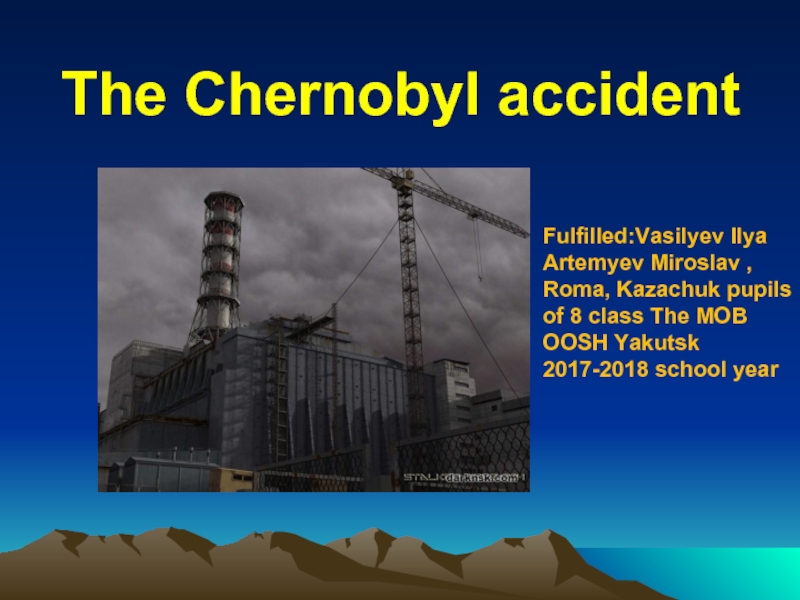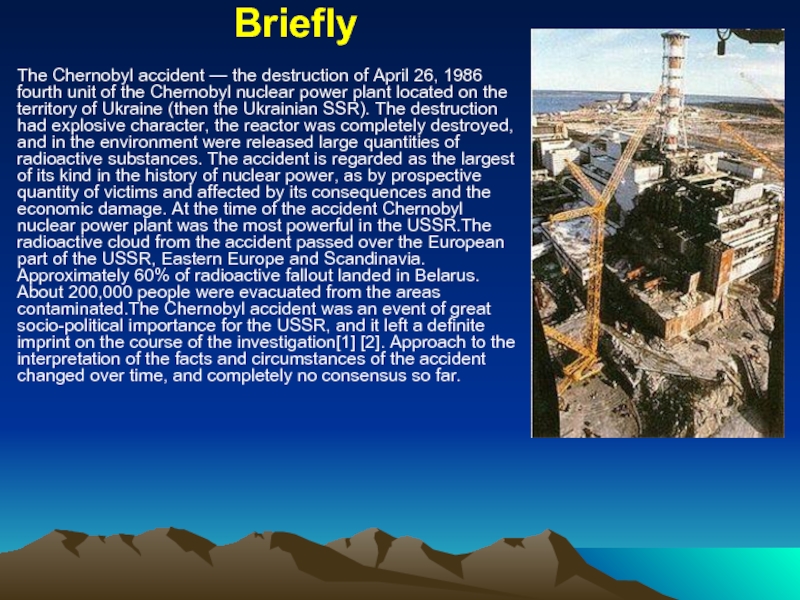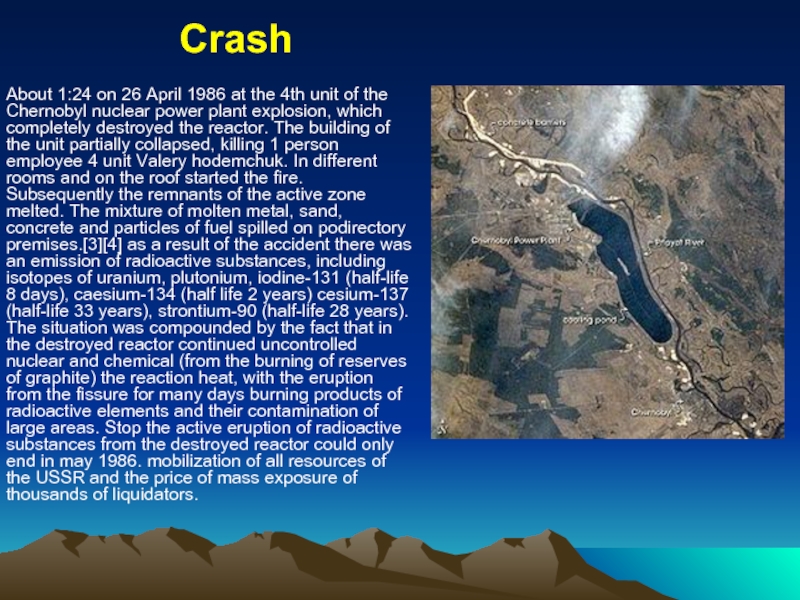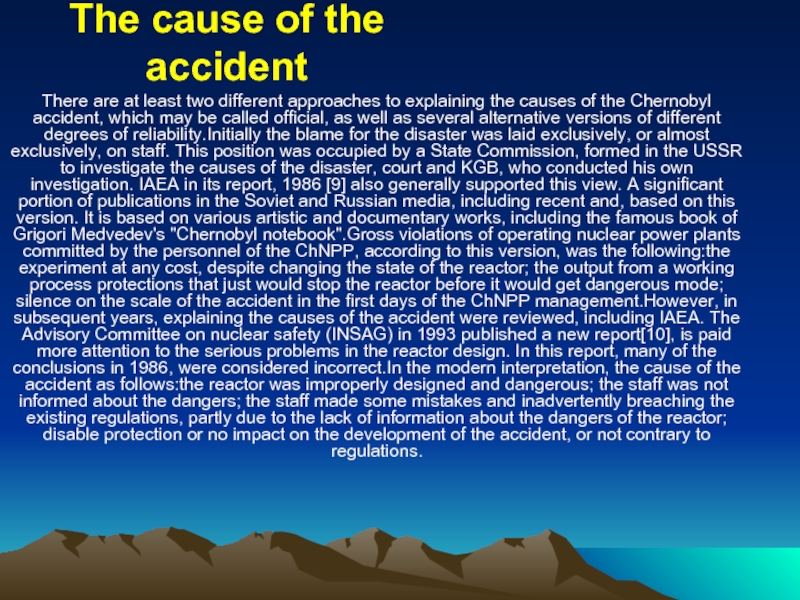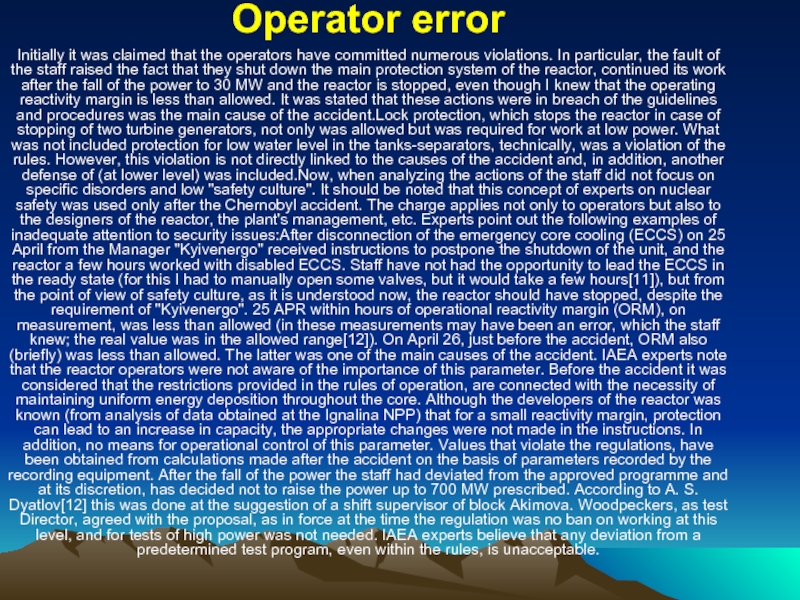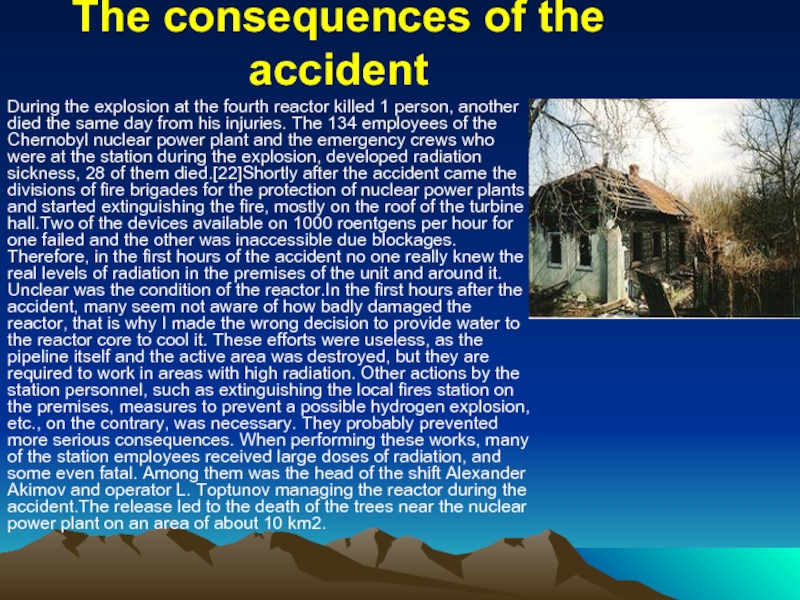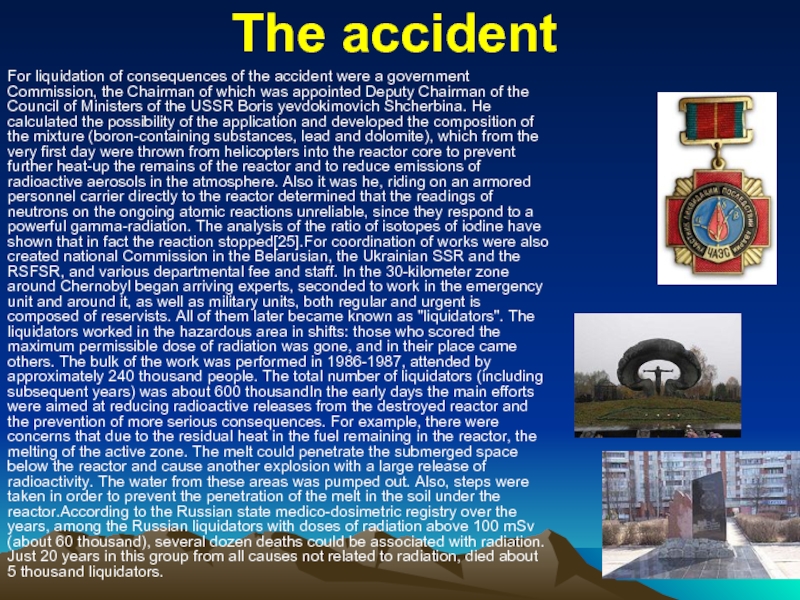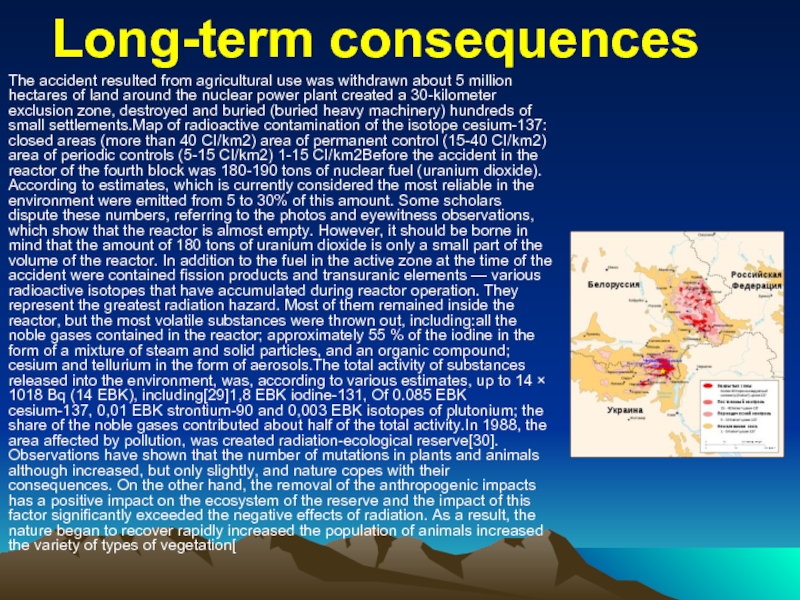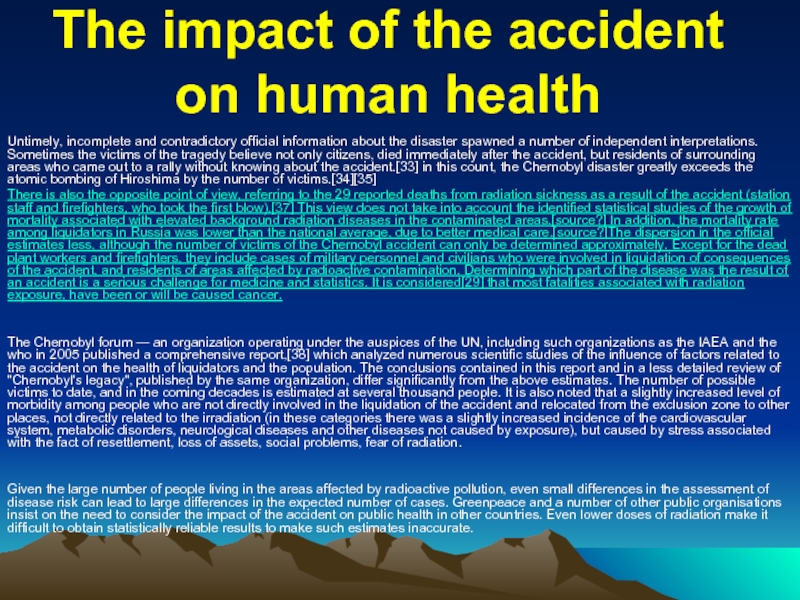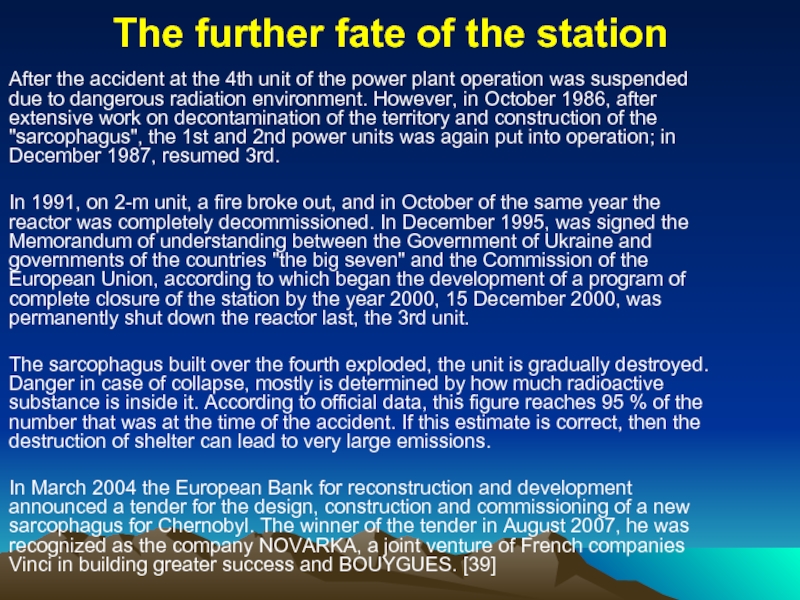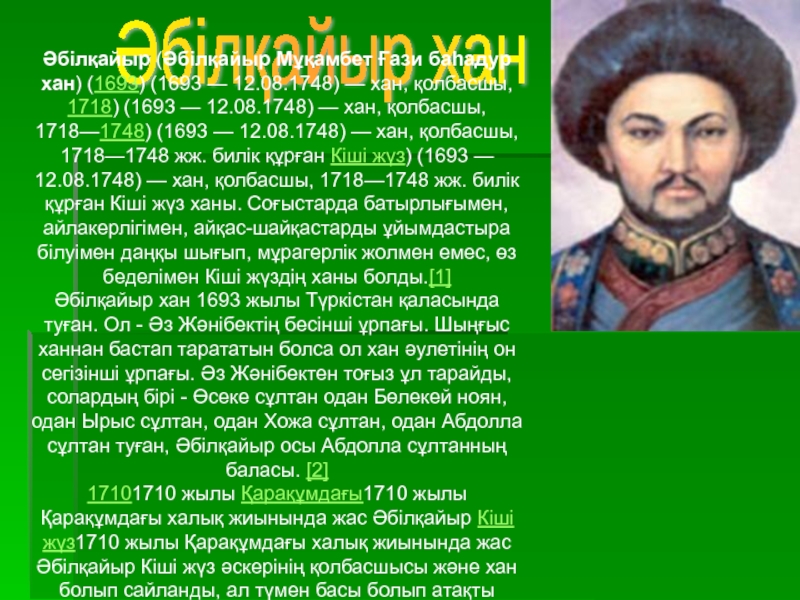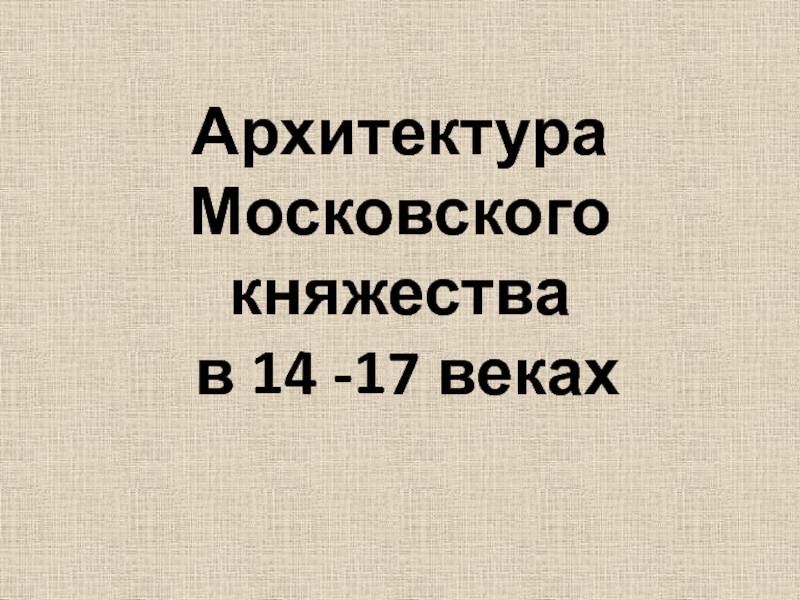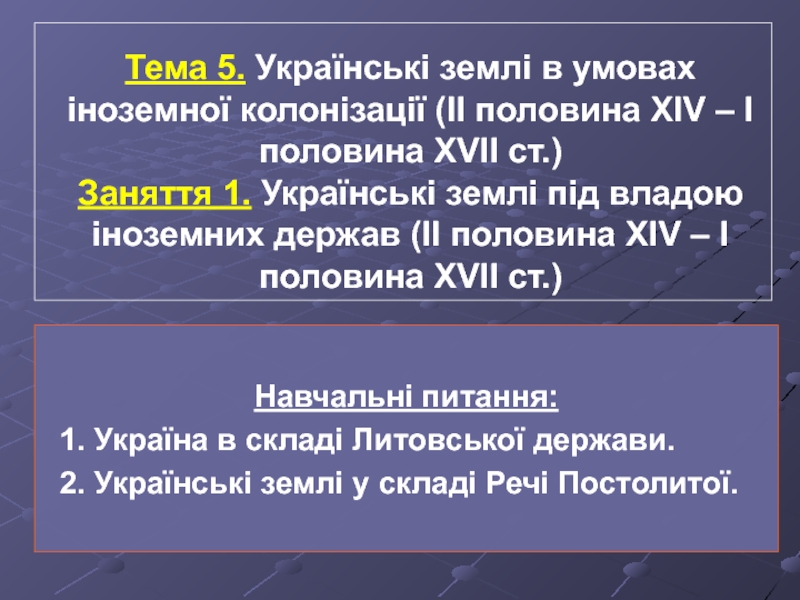8 class The MOB OOSH Yakutsk 2017-2018 school year
- Главная
- Разное
- Дизайн
- Бизнес и предпринимательство
- Аналитика
- Образование
- Развлечения
- Красота и здоровье
- Финансы
- Государство
- Путешествия
- Спорт
- Недвижимость
- Армия
- Графика
- Культурология
- Еда и кулинария
- Лингвистика
- Английский язык
- Астрономия
- Алгебра
- Биология
- География
- Детские презентации
- Информатика
- История
- Литература
- Маркетинг
- Математика
- Медицина
- Менеджмент
- Музыка
- МХК
- Немецкий язык
- ОБЖ
- Обществознание
- Окружающий мир
- Педагогика
- Русский язык
- Технология
- Физика
- Философия
- Химия
- Шаблоны, картинки для презентаций
- Экология
- Экономика
- Юриспруденция
The Chernobyl accident презентация
Содержание
- 1. The Chernobyl accident
- 2. Briefly The Chernobyl accident — the destruction
- 3. Crash About 1:24 on 26 April
- 4. The cause of the accident There are
- 5. Operator error Initially it was claimed that
- 6. The consequences of the accident During the
- 7. The accident For liquidation of consequences of
- 8. Long-term consequences The accident resulted from agricultural
- 9. The impact of the accident on human
- 10. The further fate of the station After
Слайд 2Briefly
The Chernobyl accident — the destruction of April 26, 1986 fourth
unit of the Chernobyl nuclear power plant located on the territory of Ukraine (then the Ukrainian SSR). The destruction had explosive character, the reactor was completely destroyed, and in the environment were released large quantities of radioactive substances. The accident is regarded as the largest of its kind in the history of nuclear power, as by prospective quantity of victims and affected by its consequences and the economic damage. At the time of the accident Chernobyl nuclear power plant was the most powerful in the USSR.The radioactive cloud from the accident passed over the European part of the USSR, Eastern Europe and Scandinavia. Approximately 60% of radioactive fallout landed in Belarus. About 200,000 people were evacuated from the areas contaminated.The Chernobyl accident was an event of great socio-political importance for the USSR, and it left a definite imprint on the course of the investigation[1] [2]. Approach to the interpretation of the facts and circumstances of the accident changed over time, and completely no consensus so far.
Слайд 3
Crash
About 1:24 on 26 April 1986 at the 4th unit of
the Chernobyl nuclear power plant explosion, which completely destroyed the reactor. The building of the unit partially collapsed, killing 1 person employee 4 unit Valery hodemchuk. In different rooms and on the roof started the fire. Subsequently the remnants of the active zone melted. The mixture of molten metal, sand, concrete and particles of fuel spilled on podirectory premises.[3][4] as a result of the accident there was an emission of radioactive substances, including isotopes of uranium, plutonium, iodine-131 (half-life 8 days), caesium-134 (half life 2 years) cesium-137 (half-life 33 years), strontium-90 (half-life 28 years). The situation was compounded by the fact that in the destroyed reactor continued uncontrolled nuclear and chemical (from the burning of reserves of graphite) the reaction heat, with the eruption from the fissure for many days burning products of radioactive elements and their contamination of large areas. Stop the active eruption of radioactive substances from the destroyed reactor could only end in may 1986. mobilization of all resources of the USSR and the price of mass exposure of thousands of liquidators.
Слайд 4The cause of the accident
There are at least two different approaches
to explaining the causes of the Chernobyl accident, which may be called official, as well as several alternative versions of different degrees of reliability.Initially the blame for the disaster was laid exclusively, or almost exclusively, on staff. This position was occupied by a State Commission, formed in the USSR to investigate the causes of the disaster, court and KGB, who conducted his own investigation. IAEA in its report, 1986 [9] also generally supported this view. A significant portion of publications in the Soviet and Russian media, including recent and, based on this version. It is based on various artistic and documentary works, including the famous book of Grigori Medvedev's "Chernobyl notebook".Gross violations of operating nuclear power plants committed by the personnel of the ChNPP, according to this version, was the following:the experiment at any cost, despite changing the state of the reactor; the output from a working process protections that just would stop the reactor before it would get dangerous mode; silence on the scale of the accident in the first days of the ChNPP management.However, in subsequent years, explaining the causes of the accident were reviewed, including IAEA. The Advisory Committee on nuclear safety (INSAG) in 1993 published a new report[10], is paid more attention to the serious problems in the reactor design. In this report, many of the conclusions in 1986, were considered incorrect.In the modern interpretation, the cause of the accident as follows:the reactor was improperly designed and dangerous; the staff was not informed about the dangers; the staff made some mistakes and inadvertently breaching the existing regulations, partly due to the lack of information about the dangers of the reactor; disable protection or no impact on the development of the accident, or not contrary to regulations.
Слайд 5Operator error
Initially it was claimed that the operators have committed numerous
violations. In particular, the fault of the staff raised the fact that they shut down the main protection system of the reactor, continued its work after the fall of the power to 30 MW and the reactor is stopped, even though I knew that the operating reactivity margin is less than allowed. It was stated that these actions were in breach of the guidelines and procedures was the main cause of the accident.Lock protection, which stops the reactor in case of stopping of two turbine generators, not only was allowed but was required for work at low power. What was not included protection for low water level in the tanks-separators, technically, was a violation of the rules. However, this violation is not directly linked to the causes of the accident and, in addition, another defense of (at lower level) was included.Now, when analyzing the actions of the staff did not focus on specific disorders and low "safety culture". It should be noted that this concept of experts on nuclear safety was used only after the Chernobyl accident. The charge applies not only to operators but also to the designers of the reactor, the plant's management, etc. Experts point out the following examples of inadequate attention to security issues:After disconnection of the emergency core cooling (ECCS) on 25 April from the Manager "Kyivenergo" received instructions to postpone the shutdown of the unit, and the reactor a few hours worked with disabled ECCS. Staff have not had the opportunity to lead the ECCS in the ready state (for this I had to manually open some valves, but it would take a few hours[11]), but from the point of view of safety culture, as it is understood now, the reactor should have stopped, despite the requirement of "Kyivenergo". 25 APR within hours of operational reactivity margin (ORM), on measurement, was less than allowed (in these measurements may have been an error, which the staff knew; the real value was in the allowed range[12]). On April 26, just before the accident, ORM also (briefly) was less than allowed. The latter was one of the main causes of the accident. IAEA experts note that the reactor operators were not aware of the importance of this parameter. Before the accident it was considered that the restrictions provided in the rules of operation, are connected with the necessity of maintaining uniform energy deposition throughout the core. Although the developers of the reactor was known (from analysis of data obtained at the Ignalina NPP) that for a small reactivity margin, protection can lead to an increase in capacity, the appropriate changes were not made in the instructions. In addition, no means for operational control of this parameter. Values that violate the regulations, have been obtained from calculations made after the accident on the basis of parameters recorded by the recording equipment. After the fall of the power the staff had deviated from the approved programme and at its discretion, has decided not to raise the power up to 700 MW prescribed. According to A. S. Dyatlov[12] this was done at the suggestion of a shift supervisor of block Akimova. Woodpeckers, as test Director, agreed with the proposal, as in force at the time the regulation was no ban on working at this level, and for tests of high power was not needed. IAEA experts believe that any deviation from a predetermined test program, even within the rules, is unacceptable.
Слайд 6The consequences of the accident
During the explosion at the fourth reactor
killed 1 person, another died the same day from his injuries. The 134 employees of the Chernobyl nuclear power plant and the emergency crews who were at the station during the explosion, developed radiation sickness, 28 of them died.[22]Shortly after the accident came the divisions of fire brigades for the protection of nuclear power plants and started extinguishing the fire, mostly on the roof of the turbine hall.Two of the devices available on 1000 roentgens per hour for one failed and the other was inaccessible due blockages. Therefore, in the first hours of the accident no one really knew the real levels of radiation in the premises of the unit and around it. Unclear was the condition of the reactor.In the first hours after the accident, many seem not aware of how badly damaged the reactor, that is why I made the wrong decision to provide water to the reactor core to cool it. These efforts were useless, as the pipeline itself and the active area was destroyed, but they are required to work in areas with high radiation. Other actions by the station personnel, such as extinguishing the local fires station on the premises, measures to prevent a possible hydrogen explosion, etc., on the contrary, was necessary. They probably prevented more serious consequences. When performing these works, many of the station employees received large doses of radiation, and some even fatal. Among them was the head of the shift Alexander Akimov and operator L. Toptunov managing the reactor during the accident.The release led to the death of the trees near the nuclear power plant on an area of about 10 km2.
Слайд 7The accident
For liquidation of consequences of the accident were a government
Commission, the Chairman of which was appointed Deputy Chairman of the Council of Ministers of the USSR Boris yevdokimovich Shcherbina. He calculated the possibility of the application and developed the composition of the mixture (boron-containing substances, lead and dolomite), which from the very first day were thrown from helicopters into the reactor core to prevent further heat-up the remains of the reactor and to reduce emissions of radioactive aerosols in the atmosphere. Also it was he, riding on an armored personnel carrier directly to the reactor determined that the readings of neutrons on the ongoing atomic reactions unreliable, since they respond to a powerful gamma-radiation. The analysis of the ratio of isotopes of iodine have shown that in fact the reaction stopped[25].For coordination of works were also created national Commission in the Belarusian, the Ukrainian SSR and the RSFSR, and various departmental fee and staff. In the 30-kilometer zone around Chernobyl began arriving experts, seconded to work in the emergency unit and around it, as well as military units, both regular and urgent is composed of reservists. All of them later became known as "liquidators". The liquidators worked in the hazardous area in shifts: those who scored the maximum permissible dose of radiation was gone, and in their place came others. The bulk of the work was performed in 1986-1987, attended by approximately 240 thousand people. The total number of liquidators (including subsequent years) was about 600 thousandIn the early days the main efforts were aimed at reducing radioactive releases from the destroyed reactor and the prevention of more serious consequences. For example, there were concerns that due to the residual heat in the fuel remaining in the reactor, the melting of the active zone. The melt could penetrate the submerged space below the reactor and cause another explosion with a large release of radioactivity. The water from these areas was pumped out. Also, steps were taken in order to prevent the penetration of the melt in the soil under the reactor.According to the Russian state medico-dosimetric registry over the years, among the Russian liquidators with doses of radiation above 100 mSv (about 60 thousand), several dozen deaths could be associated with radiation. Just 20 years in this group from all causes not related to radiation, died about 5 thousand liquidators.
Слайд 8Long-term consequences
The accident resulted from agricultural use was withdrawn about 5
million hectares of land around the nuclear power plant created a 30-kilometer exclusion zone, destroyed and buried (buried heavy machinery) hundreds of small settlements.Map of radioactive contamination of the isotope cesium-137: closed areas (more than 40 CI/km2) area of permanent control (15-40 CI/km2) area of periodic controls (5-15 CI/km2) 1-15 CI/km2Before the accident in the reactor of the fourth block was 180-190 tons of nuclear fuel (uranium dioxide). According to estimates, which is currently considered the most reliable in the environment were emitted from 5 to 30% of this amount. Some scholars dispute these numbers, referring to the photos and eyewitness observations, which show that the reactor is almost empty. However, it should be borne in mind that the amount of 180 tons of uranium dioxide is only a small part of the volume of the reactor. In addition to the fuel in the active zone at the time of the accident were contained fission products and transuranic elements — various radioactive isotopes that have accumulated during reactor operation. They represent the greatest radiation hazard. Most of them remained inside the reactor, but the most volatile substances were thrown out, including:all the noble gases contained in the reactor; approximately 55 % of the iodine in the form of a mixture of steam and solid particles, and an organic compound; cesium and tellurium in the form of aerosols.The total activity of substances released into the environment, was, according to various estimates, up to 14 × 1018 Bq (14 EBK), including[29]1,8 EBK iodine-131, Of 0.085 EBK cesium-137, 0,01 EBK strontium-90 and 0,003 EBK isotopes of plutonium; the share of the noble gases contributed about half of the total activity.In 1988, the area affected by pollution, was created radiation-ecological reserve[30]. Observations have shown that the number of mutations in plants and animals although increased, but only slightly, and nature copes with their consequences. On the other hand, the removal of the anthropogenic impacts has a positive impact on the ecosystem of the reserve and the impact of this factor significantly exceeded the negative effects of radiation. As a result, the nature began to recover rapidly increased the population of animals increased the variety of types of vegetation[
Слайд 9The impact of the accident on human health
Untimely, incomplete and contradictory
official information about the disaster spawned a number of independent interpretations. Sometimes the victims of the tragedy believe not only citizens, died immediately after the accident, but residents of surrounding areas who came out to a rally without knowing about the accident.[33] in this count, the Chernobyl disaster greatly exceeds the atomic bombing of Hiroshima by the number of victims.[34][35]
There is also the opposite point of view, referring to the 29 reported deaths from radiation sickness as a result of the accident (station staff and firefighters, who took the first blow).[37] This view does not take into account the identified statistical studies of the growth of mortality associated with elevated background radiation diseases in the contaminated areas.[source?] In addition, the mortality rate among liquidators in Russia was lower than the national average, due to better medical care.[source?]The dispersion in the official estimates less, although the number of victims of the Chernobyl accident can only be determined approximately. Except for the dead plant workers and firefighters, they include cases of military personnel and civilians who were involved in liquidation of consequences of the accident, and residents of areas affected by radioactive contamination. Determining which part of the disease was the result of an accident is a serious challenge for medicine and statistics. It is considered[29] that most fatalities associated with radiation exposure, have been or will be caused cancer.
The Chernobyl forum — an organization operating under the auspices of the UN, including such organizations as the IAEA and the who in 2005 published a comprehensive report,[38] which analyzed numerous scientific studies of the influence of factors related to the accident on the health of liquidators and the population. The conclusions contained in this report and in a less detailed review of "Chernobyl's legacy", published by the same organization, differ significantly from the above estimates. The number of possible victims to date, and in the coming decades is estimated at several thousand people. It is also noted that a slightly increased level of morbidity among people who are not directly involved in the liquidation of the accident and relocated from the exclusion zone to other places, not directly related to the irradiation (in these categories there was a slightly increased incidence of the cardiovascular system, metabolic disorders, neurological diseases and other diseases not caused by exposure), but caused by stress associated with the fact of resettlement, loss of assets, social problems, fear of radiation.
Given the large number of people living in the areas affected by radioactive pollution, even small differences in the assessment of disease risk can lead to large differences in the expected number of cases. Greenpeace and a number of other public organisations insist on the need to consider the impact of the accident on public health in other countries. Even lower doses of radiation make it difficult to obtain statistically reliable results to make such estimates inaccurate.
There is also the opposite point of view, referring to the 29 reported deaths from radiation sickness as a result of the accident (station staff and firefighters, who took the first blow).[37] This view does not take into account the identified statistical studies of the growth of mortality associated with elevated background radiation diseases in the contaminated areas.[source?] In addition, the mortality rate among liquidators in Russia was lower than the national average, due to better medical care.[source?]The dispersion in the official estimates less, although the number of victims of the Chernobyl accident can only be determined approximately. Except for the dead plant workers and firefighters, they include cases of military personnel and civilians who were involved in liquidation of consequences of the accident, and residents of areas affected by radioactive contamination. Determining which part of the disease was the result of an accident is a serious challenge for medicine and statistics. It is considered[29] that most fatalities associated with radiation exposure, have been or will be caused cancer.
The Chernobyl forum — an organization operating under the auspices of the UN, including such organizations as the IAEA and the who in 2005 published a comprehensive report,[38] which analyzed numerous scientific studies of the influence of factors related to the accident on the health of liquidators and the population. The conclusions contained in this report and in a less detailed review of "Chernobyl's legacy", published by the same organization, differ significantly from the above estimates. The number of possible victims to date, and in the coming decades is estimated at several thousand people. It is also noted that a slightly increased level of morbidity among people who are not directly involved in the liquidation of the accident and relocated from the exclusion zone to other places, not directly related to the irradiation (in these categories there was a slightly increased incidence of the cardiovascular system, metabolic disorders, neurological diseases and other diseases not caused by exposure), but caused by stress associated with the fact of resettlement, loss of assets, social problems, fear of radiation.
Given the large number of people living in the areas affected by radioactive pollution, even small differences in the assessment of disease risk can lead to large differences in the expected number of cases. Greenpeace and a number of other public organisations insist on the need to consider the impact of the accident on public health in other countries. Even lower doses of radiation make it difficult to obtain statistically reliable results to make such estimates inaccurate.
Слайд 10The further fate of the station
After the accident at the 4th
unit of the power plant operation was suspended due to dangerous radiation environment. However, in October 1986, after extensive work on decontamination of the territory and construction of the "sarcophagus", the 1st and 2nd power units was again put into operation; in December 1987, resumed 3rd.
In 1991, on 2-m unit, a fire broke out, and in October of the same year the reactor was completely decommissioned. In December 1995, was signed the Memorandum of understanding between the Government of Ukraine and governments of the countries "the big seven" and the Commission of the European Union, according to which began the development of a program of complete closure of the station by the year 2000, 15 December 2000, was permanently shut down the reactor last, the 3rd unit.
The sarcophagus built over the fourth exploded, the unit is gradually destroyed. Danger in case of collapse, mostly is determined by how much radioactive substance is inside it. According to official data, this figure reaches 95 % of the number that was at the time of the accident. If this estimate is correct, then the destruction of shelter can lead to very large emissions.
In March 2004 the European Bank for reconstruction and development announced a tender for the design, construction and commissioning of a new sarcophagus for Chernobyl. The winner of the tender in August 2007, he was recognized as the company NOVARKA, a joint venture of French companies Vinci in building greater success and BOUYGUES. [39]
In 1991, on 2-m unit, a fire broke out, and in October of the same year the reactor was completely decommissioned. In December 1995, was signed the Memorandum of understanding between the Government of Ukraine and governments of the countries "the big seven" and the Commission of the European Union, according to which began the development of a program of complete closure of the station by the year 2000, 15 December 2000, was permanently shut down the reactor last, the 3rd unit.
The sarcophagus built over the fourth exploded, the unit is gradually destroyed. Danger in case of collapse, mostly is determined by how much radioactive substance is inside it. According to official data, this figure reaches 95 % of the number that was at the time of the accident. If this estimate is correct, then the destruction of shelter can lead to very large emissions.
In March 2004 the European Bank for reconstruction and development announced a tender for the design, construction and commissioning of a new sarcophagus for Chernobyl. The winner of the tender in August 2007, he was recognized as the company NOVARKA, a joint venture of French companies Vinci in building greater success and BOUYGUES. [39]
